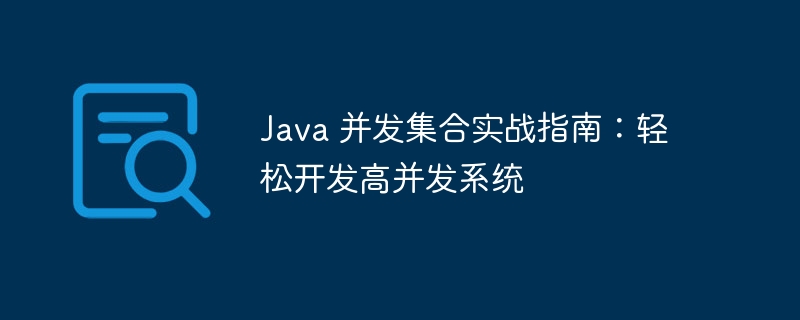

#The book "Java Concurrent Collections Practical Guide: Easily Developing High Concurrency Systems" recommended by php editor Xigua is a practical guide for Java developers to apply concurrent collections in actual projects. Through this book, readers can learn how to use the concurrent collection classes provided by Java to easily develop high-concurrency systems and improve the performance and stability of the system. This book is a rare practical guide for developers who want to understand concurrency programming in depth and improve the concurrency processing capabilities of the system.
Java Concurrent Collections are part of the Java Collections Framework and are designed for multi-threadedprogramming. They provide a series of threadsafe collection classes that can be used to store and manage shared data. The main advantages of Java concurrent collections include:
Thread safety: Java concurrent collections are carefully designed to ensure the consistency and integrity of data in a multi-threaded environment.
Efficiency: Java concurrent collections have been optimized to provide high-performance concurrent access performance.
Ease of use: Java concurrent collections provide an intuitive and simple api that is easy to use and understand.
2. Types of Java concurrent collections
Java concurrent collections mainly include the following types:
List: A collection used to store an ordered list of elements, supporting fast random access.
Set: A collection used to store unique elements, supporting fast search and deletion.
Map: Used to store a collection of key-value pairs, supporting efficient search for values based on keys.
Queue: A FIFO (first in first out) or LIFO (last in first out) queue for storing elements.
BlockingQueue: A blocking queue used to store elements, supporting thread-safe blocking enqueue and dequeue operations.
3. Usage of Java concurrent collections
The following are some examples to demonstrate the usage of Java concurrent collections:
ConcurrentHashMap<String, Object> sharedDataMap = new ConcurrentHashMap<>();
// 线程 1
sharedDataMap.put("key1", "value1");
// 线程 2
Object value2 = sharedDataMap.get("key1");CopyOnWriteArrayList<String> threadSafeList = new CopyOnWriteArrayList<>();
// 线程 1
threadSafeList.add("element1");
// 线程 2
String element1 = threadSafeList.get(0);BlockingQueue<Integer> blockingQueue = new ArrayBlockingQueue<>(10); // 生产者线程 blockingQueue.put(1); // 消费者线程 Integer value = blockingQueue.take();
4. Frequently Asked Questions
Choosing the appropriate Java concurrent collection depends on the specific needs of your application. In general, if you need a thread-safe list, use CopyOnWriteArrayList. If you need a thread-safe hash table, you can use ConcurrentHashMap. If you need a thread-safe queue, you can use BlockingQueue.
Java concurrent collections are optimized to provide high-performance concurrent access performance. However, due to the presence of thread safety mechanisms, the performance of Java concurrent collections may be slightly lower than non-thread-safe collections.
Java concurrent collections do not support all Java collection operations. For example, Java concurrent collections do not support the iterator remove operation. If you need to support all Java collection operations, you can use a non-blocking concurrent collection such as ConcurrentLinkedQueue or ConcurrentSkipListSet.
5. Summary
Java concurrent collections are a magic weapon for handling concurrent programming in the Java language. They provide efficient, safe, and easy-to-use collection classes to help developers easily build high-concurrency systems. Through Learning of this article, you should have mastered the characteristics, usage and some common examples of Java concurrent collections. Now you can confidently use Java concurrent collections in your projects and enjoy the convenience and high performance they bring.
The above is the detailed content of Java Concurrent Collections Practical Guide: Easily Develop High Concurrency Systems. For more information, please follow other related articles on the PHP Chinese website!




